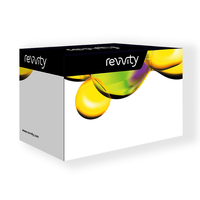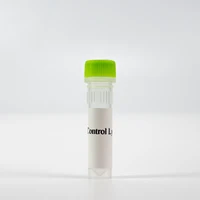

HTRF Human and Mouse Phospho-RET (pan) Detection Kit, 500 Assay Points






This HTRF kit enables the cell-based quantitative detection of phosphorylated RET on Tyrosines as a readout of neurotrophic factor activation.
For research use only. Not for use in diagnostic procedures. All products to be used in accordance with applicable laws and regulations including without limitation, consumption & disposal requirements under European REACH regulations (EC 1907/2006).
Product information
Overview
The HTRF Phospho-RET (pan) cell-based assay conveniently and accurately detects phosphorylated RET on Tyrosine residues. The assay measures both short and long RET isoforms.
The proto-oncogene RET (Rearranged during Transfection), also known as c-Ret, is a receptor tyrosine kinase primarily expressed as two isoforms of 1072 & 1114 amino acids. RET activation by Glial cell line-derived neurotrophic Family Ligands (GFL) leads to its dimerization and autophosphorylation on intracellular Tyrosine residues. RET is required for the development of the nervous system and several other tissues. RET alterations have been detected in numerous human cancers. The development of highly selective and potent RET kinase inhibitors is therefore of great interest to treat RET-altered cancers. Recently, RET has also been linked to neurodegeneration.
Specifications
| Application |
Protein Detection
|
|---|---|
| Assay Points |
500
|
| Assay Target Type |
Kit
|
| Assay Technology |
HTRF
|
| Automation Compatible |
Yes
|
| Brand |
HTRF
|
| Detection Method |
HTRF
|
| Experimental Type |
In vitro
|
| Quantity |
1
|
| Therapeutic Area |
Oncology & Inflammation
|
| Unit Size |
500 Assay Points
|
Video gallery


How it works
Phospho-RET (pan) assay principle
The Phospho-RET (pan) assay measures RET when phosphorylated on Tyrosines. Unlike Western Blot, the assay is entirely plate-based and does not require gels, electrophoresis, or transfer. The assay uses 2 antibodies, one labeled with a donor fluorophore and the other with an acceptor. The first antibody is selected for its specific binding to phosphorylated tyrosine residues, the second for its ability to recognize specifically the protein independently of its phosphorylation state. Protein phosphorylation enables an immune-complex formation involving both labeled antibodies, and which brings the donor fluorophore into close proximity to the acceptor, thereby generating a FRET signal. Its intensity is directly proportional to the concentration of phosphorylated protein present in the sample, and provides a means of assessing the protein's phosphorylation state under a no-wash assay format.

Phospho-RET (pan) two-plate assay protocol
The two-plate protocol involves culturing cells in a 96-well plate before lysis, then transferring lysates into a 384-well low volume detection plate before the addition of Phospho-RET (pan) HTRF detection reagents. This protocol enables the cells' viability and confluence to be monitored.

Phospho-RET (pan) one-plate assay protocol
Detection of Phosphorylated RET (pan) with HTRF reagents can be performed in a single plate used for culturing, stimulation, and lysis. No washing steps are required. This HTS designed protocol enables miniaturization while maintaining robust HTRF quality.

Assay validation
Induction of RET phosphorylation in mouse neuroblastoma Neuro-2a cells
The mouse neuroblastoma cell line Neuro-2a was seeded in a 96-well culture-treated plate under 50,000 cells/well in complete culture medium, and incubated overnight at 37 °C, 5% CO2. The cells were treated for 15 minutes with increasing concentrations of Pervanadate, in absence or in presence of mouse GDNF at 100 ng/mL. After treatment, the cells were lysed with 50 µL of supplemented lysis buffer #4 for 30 minutes at RT under gentle shaking. For the detection step, 16 µL of cell lysate were transferred into a 384-well low volume white microplate and 4 µL of the HTRF Phospho-RET (pan) or Total-RET detection reagents were added. The HTRF signal was recorded after an overnight incubation.
GDNF-induced RET phosphorylation is visible in absence of Pervanadate, and the detection is improved in presence of 6.25 µM and 12.5 µM Pervanadate (prevention of tyrosine dephosphorylation). The highest level of Phospho-RET is obtained with 50 µM Pervanadate alone.
The total RET assay shows a constant level of Total RET in all experimental conditions, confirming that high doses of Pervanadate did not induce cell detachment.


Inhibition of RET phosphorylation in mouse neuroblastoma Neuro-2a cells
The mouse neuroblastoma cell line Neuro-2a was seeded in a 96-well culture-treated plate under 100,000 cells/well in complete culture medium, and incubated overnight at 37 °C, 5% CO2. The cells were treated for 2 hours with increasing doses of Pralsetinib, and 100 µM Pervanadate were added 30 minutes before the end of the treatment. The cells were lysed with 50 µL of supplemented lysis buffer #4 for 30 minutes at RT under gentle shaking. For the detection step, 16 µL of cell lysate were transferred into a 384-well low volume white microplate and 4 µL of the HTRF Phospho-RET (pan) or Total-RET detection reagents were added. The HTRF signal was recorded after an overnight incubation.
As expected, the RET kinase inhibitor Pralsetinib induced a dose-dependent decrease in RET phosphorylation, without effect on the expression level of the receptor.

Inhibition of RET phosphorylation in human neuroblastoma SH-SY5Y cells
The human neuroblastoma cell line SH-SY5Y was seeded in a 96-well culture-treated plate under 100,000 cells/well in complete culture medium, and incubated overnight at 37 °C, 5% CO2. The cells were treated for 2 hours with increasing doses of Pralsetinib and Selpercatinib, and 100 µM Pervanadate were added 30 minutes before the end of the treatment. The cells were lysed with 50 µL of supplemented lysis buffer #4 for 30 minutes at RT under gentle shaking. For the detection step, 16 µL of cell lysate were transferred into a 384-well low volume white microplate and 4 µL of the HTRF Phospho-RET (pan) or Total-RET detection reagents were added. The HTRF signal was recorded after an overnight incubation.
As expected, both RET kinase inhibitors induced a dose-dependent decrease in RET phosphorylation, without effect on the expression level of the receptor.


Inhibition of RET phosphorylation in the human lung adenocarcinoma cell line LC-2/ad
The human lung adenocarcinoma cell line LC-2/ad was seeded in a 96-well culture-treated plate under 50,000 cells/well in complete culture medium, and incubated overnight at 37 °C, 5% CO2. The cells were treated for 2 hours with increasing doses of Pralsetinib, and 100 µM Pervanadate were added 30 minutes before the end of the treatment. The cells were lysed with 50 µL of supplemented lysis buffer #4 for 30 minutes at RT under gentle shaking. For the detection step, 16 µL of cell lysate were transferred into a 384-well low volume white microplate and 4 µL of the HTRF Phospho-RET (pan) or Total-RET detection reagents were added. The HTRF signal was recorded after an overnight incubation.
As expected, the RET kinase inhibitor Pralsetinib induced a dose-dependent decrease in RET phosphorylation, without significant effect on the expression level of the receptor.

Simplified pathway
RET signaling pathway
RET is activated by Glial cell line-derived neurotrophic Family Ligands (GFL) including GDNF (glial cell line-derived neurotrophic factor), NRTN (neurturin), ARTN (artemin) and PSPN (persephin). Ligand binding to GDNF Family Receptor-α co-receptors (GFRα1/2/3/4) triggers the formation of a complex with RET, leading to RET dimerization and autophosphorylation on multiple intracellular tyrosines. Phosphorylated tyrosine residues serve as docking sites for various adaptor proteins that induce the activation of downstream signaling pathways (MAPK, PI3K/AKT, STAT3...) necessary for cell survival, differentiation, proliferation and motility.

Resources
This guide provides you an overview of HTRF applications in several therapeutic areas.

SDS, COAs, Manuals and more
Are you looking for technical documents for this product. We have housed them in a dedicated section., click on the links below to explore.


How can we help you?
We are here to answer your questions.
































